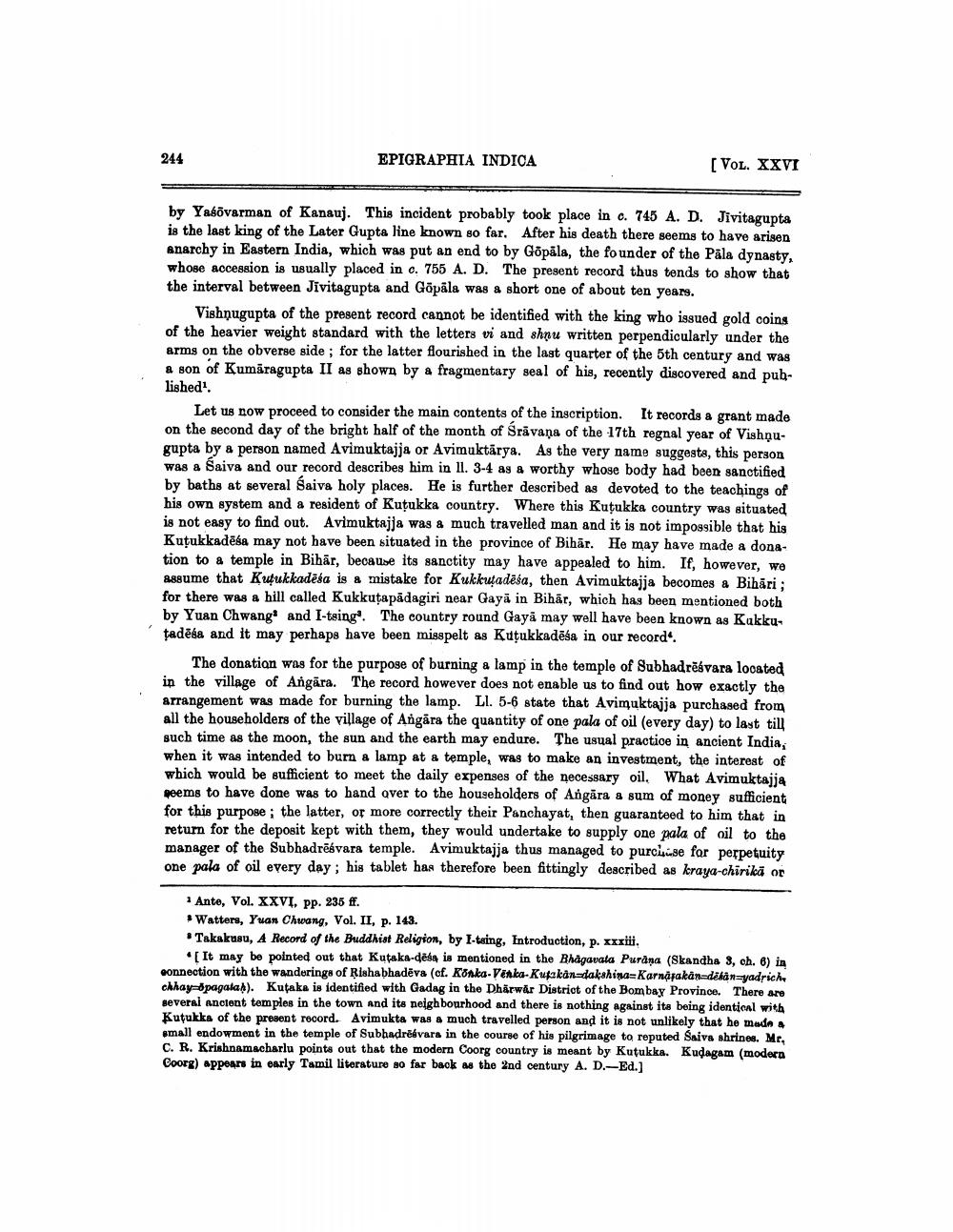________________
244
EPIGRAPHIA INDICA
[VOL. XXVI
by Yakövarman of Kanauj. This incident probably took place in o. 745 A. D. Jivitagupta is the last king of the Later Gupta line known so far. After his death there seems to have arisen enarchy in Eastern India, which was put an end to by Gopāla, the founder of the Pāla dynasty, whose accession is usually placed in c. 755 A. D. The present record thus tends to show that the interval between Jivitagupta and Gõpāla was a short one of about ten years.
Vishnugupta of the present record cannot be identified with the king who issued gold coins of the heavier weight standard with the letters vi and shnu written perpendicularly under the arms on the obverse side ; for the latter flourished in the last quarter of the 5th century and was a son of Kumāragupta II as shown by a fragmentary seal of his, recently discovered and published1
Let us now proceed to consider the main contents of the inscription. It records a grant made on the second day of the bright half of the month of Srāvana of the 17th regnal year of Vishnugupta by & person named Avimuktajja or Avimuktarya. As the very name suggests, this person was a Saiva and our record describes him in II. 3-4 as a worthy whose body had been sanctified by baths at several Saiva holy places. He is further described as devoted to the teachings of his own system and a resident of Kutukka country. Where this Kutukka country was situated is not easy to find out. Avimuktajja was a much travelled man and it is not impossible that his Kuţukkadēsa may not have been situated in the province of Bihär. He may have made a donation to a temple in Bihär, because its sanctity may have appealed to him. If, however, we assume that Kuukkadēša is a mistake for Kukkutadeśa, then Avimuktajja becomes & Bihāri ; for there was a hill called Kukkutapädagiri near Gaya in Bihār, which has been mentioned both by Yuan Chwange and I-tsinge. The country round Gaya may well have been known as Kakkutadēla and it may perhaps have been misspelt as Kuțukkadēša in our record
The donation was for the purpose of burning a lamp in the temple of Subhadrēšvara located in the village of Angāra. The record however does not enable us to find out how exactly the arrangement was made for burning the lamp. LI. 5-6 state that Avimuktajja purchased from all the householders of the village of Angara the quantity of one pala of oil (every day) to last till such time as the moon, the sun and the earth may endure. The usual practice in ancient India, when it was intended to bum a lamp at a temple, was to make an investment, the interest of which would be sufficient to meet the daily expenses of the necessary oil. What Avimuktajja seems to have done was to hand over to the householders of Angära a sum of money sufficient for this purpose : the latter, or more correctly their Panchayat, then guaranteed to him that in return for the deposit kept with them, they would undertake to supply one pala of oil to the manager of the Subhadrēsvara temple. Avimuktajja thus managed to purchase for perpetuity one pala of oil every day; his tablet has therefore been fittingly described as keraya-chirikā or
1 Ante, Vol. XXVI, pp. 235 ff.
Watters, Yuan Chwang, Vol. II, p. 143. • Takakusu, A Record of the Buddhist Religion, by I-tsing, Introduction, p. xxxii.
• It may be pointed out that Kutaka-desa is mentioned in the Bhagavala Purana (Skandha 3, ch. 6) in connection with the wanderings of Rishabhadeva (cf. Konka-Venka-Kupakan dakshina=Karnapakan dekan-yadrich ckhay-dpagalas). Kutaka is identified with Gadag in the Dhärwer District of the Bombay Province. There are severai ancient temples in the town and its neighbourhood and there is nothing against its being identical with Kutukks of the present record. Avimukta was & much travelled person and it is not unlikely that he made amall endowment in the temple of Subhadrevara in the course of his pilgrimage to reputed Saiva shrines. Me. C. R. Krishnamacharlu points out that the modern Coorg country is meant by Kutukka. Kudagam (modern Coorg) appears in early Tamil literature so far back as the 2nd century A. D.-Ed.)




